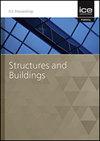The behavior of thermally-shocked RC columns confined internally by ASWM
IF 1.4
4区 工程技术
Q3 CONSTRUCTION & BUILDING TECHNOLOGY
Proceedings of the Institution of Civil Engineers-Structures and Buildings
Pub Date : 2023-10-12
DOI:10.1680/jstbu.22.00226
引用次数: 0
Abstract
In the paper, an experimental program of twenty-four square columns of 200 mm side length and 1000 mm height were tested under the effect of utilizing the ASWM different number of layers (one, two, three. four, and five) as a substitute for stirrup reinforcement within the middle region of the column height, and the effect of thermal shock (damaged or undamaged). The tested columns were divided into two main sets (damaged or undamaged), each consisting of twelve specimens. Sufficient ties were provided at the column ends to prevent premature failure. Moreover, the ASWM provided the columns with the required lateral confinement based on the number of applied layers and the concrete compressive strength. It has been proved that thermal shock reduces the concrete compressive strength, thus degrading the column's performance in terms of its feasibility, strength, and stiffness. The used ASWM layer numbers significantly affect the ductility, energy absorption, and column axial capacity, but this improvement is limited to ASWM numbers of 4 or 5 while stiffness keeps increasing for all values. Furthermore, the average enhancement in the column's axial capacity is equal to 15% on average for the intact specimen. Moreover, this is reduced by approximately 10% under the thermal shock effect.ASWM内约束RC柱的热冲击性能
本文以24根边长200 mm、高1000 mm的方形柱为实验对象,在不同层数(1层、2层、3层)的ASWM作用下进行了试验。(四)和(五)作为箍筋的替代,在中间区域内加固立柱的高度,并影响热冲击(损坏或未损坏)。测试柱分为两组(损坏或未损坏),每组由12个试件组成。在柱端设置了足够的连接以防止过早破坏。此外,ASWM根据层数和混凝土抗压强度为柱提供所需的侧向约束。事实证明,热冲击降低了混凝土的抗压强度,从而降低了柱的可行性、强度和刚度性能。采用的ASWM层数对延性、能量吸收和柱轴向承载力有显著影响,但这种改善仅限于ASWM层数为4或5,而刚度在所有值下都在不断增加。此外,柱的轴向容量的平均增强平均为15%,为完整的标本。此外,在热冲击效应下,这可以减少约10%。
本文章由计算机程序翻译,如有差异,请以英文原文为准。
求助全文
约1分钟内获得全文
求助全文
来源期刊
CiteScore
3.40
自引率
6.20%
发文量
61
审稿时长
12 months
期刊介绍:
Structures and Buildings publishes peer-reviewed papers on the design and construction of civil engineering structures and the applied research associated with such activities. Topics include the design, strength, durability and behaviour of structural components and systems.
Topics covered: energy conservation, people movement within and around buildings, strength and durability of steel and concrete structural components, and the behaviour of building and bridge components and systems

 求助内容:
求助内容: 应助结果提醒方式:
应助结果提醒方式:


